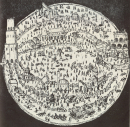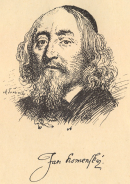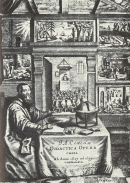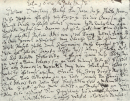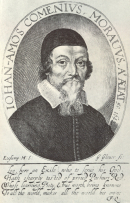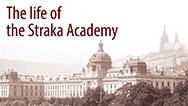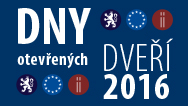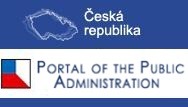Important personalities
15. 11. 2010
On 15th November 440 years will have gone by since the death of John Amos Comenius
Parents of Comenius died soon after each other in 1604 when Comenius was twelve years old. Then he lived with his aunt from the father side in Strážnice where attended the Brethren school. When Strážnice was burned down by troops of the Transylvanian duke Stephen Bocskay, who was a leader of the Estates' rebellion against Hapsburgs, Comenius lost his home for the second time and left for Nivnice where he lived with his new guardians. In 1608 he began to study at the Brethren school in Přerov which was supported by a political patron of the Unity of the Brethren Charles the elder of Žerotín. From 1611 to 1614 he was studying at German reformed schools – at the Herborn Academy and at the University of Heidelberg. During his studies he began to write his first literary works but they remained unfinished.
After his return to Moravia he became a head of the Brethren school in Přerov and a preacher of the Unity of the Brethren. In 1918 he left for Fulnek where he became a rector of the Unity of the Brethren and a teacher; he also set up his home there. After the defeat of the Czech estates in the Battle of White Mountain in 1620 the anti-reformation began and Comenius had to be in hiding. Finally he found his refuge at the domain of Charles the elder of Žerotín. In 1622 his wife Magdalene and two sons died of plague. In 1624 he found refuge at the domain of Charles the elder of Žerotín in Brandýs nad Orlicí; there he also met his second wife, Marie Dorota Cyrilová. He got married to her in 1624; they lived together for twenty-four years and had four children – three daughters and a son. Comenius then became one of leading personalities of the Unity of the Brethren, he often travelled abroad and he tried to gain support for the Unity of the Brethren there. He was also engaged in the transport of the printing machine from Kraslice to Vratislav. The last two years Comenius spent in Bílá Třemešná near Dvůr Králové at the fort of a brethren knight Jiří Sadovský of Sloupno.
When the Emperor Ferdinand II ordered through his patent of 31 July 1627 non-catholic estates to convert to the Catholic religion or to leave the country within six months, John Amos Comenius, together with his family left for Leszno where he arrived in February 1628. He spent in Lezno, which was a destination of protestant refugees of various countries, during his three stay altogether nineteen years. Comenius gave lessons at the Higher Protestant School, he prepared textbooks and linguistic studies, he became a member of the Unity of Brethren's leadership and in 1632 a bishop; he kept up frequent correspondence with many European scholars. During his first stay in Leszno he wrote the book for mothers and nannies Informatorium Scholae Maternale (1630), the textbook Janua Lingrurarum Reserata (1630, The Gate of Languages Unlocked), philosophical-religious paper Centrum Securitatis (The Centre of Safety, 1633). In 1631 he also published the alogeric prose Labyrinth of the World and Paradise of the Heart which he wrote in 1623. The book Prodromos Pansophinae was published in England in 1639.
In 1641 Comenius accepted the offer of a mercantile entrepreneur Hartlib to work in England and to reform the school system there. In London Comenius found understanding for his plans for organizing knowledge, including material security. Following the incentive of his English friends he prepared the project of the international academy Collegium Lucis; in connection with this book he wrote a programme paper Via Lucis (Way of Light). However, in 1642 a civil war outbreak in England and Comenius had to leave the country.
From lots of invitations which he had received, he chose the offer to prepare a reform of the school system in Sweden. On his way to Sweden, Comenius met a French philosopher René Descartes in Nederland, one of the greatest personalities of science and philosophy of that time. Comenius lived in Stockholm and later on, on the recommendation of Swedes, he settled in the Polish town Elblag, which was then under Sweden administration. He worked there with his assistants on textbooks for Sweden schools and he was also engaged in his work on Pansofia which is science on all phenomena in the world. During his work Comenius encountered difficulties, Swedes blamed him for not keeping deadlines and also his participation in the ecumenical session in Thorunia where issues of rapprochement of churches and their settlement were discussed in spite of the fact that conclusions of the council were not in compliance with the Sweden policy. Comenius interceded with the Chancellor Oxisterna and the Queen Christine on behalf of support of the Czech nation and the Unity of Brethrens. However, the Westfalian Peace signed in 1648 meant the greatest blow to the Comenius's political hopes and his chances to return to his motherland. Nevertheless, he never abandoned these hopes and expected that a political reversal would take place on the European political scene. He was often given support through various prophecies; he was also blamed for an excessive trust in prophecies by some of his contemporaries.
In 1648 Comenius returned to Leszno where soon after that died his second wife. In 1649 Comenius got married to his third wife who was Jana Gajusová. In 1650 he accepted the invitation of the Hungarian Duke Zikmund Rakocsi of Sarospatak Comenius was to reform the Transylvanian school system there and to organize the Pansophic School. In this period he wrote for example the work Schola Ludus (1654). After the death of the duke, Comenius, due to the lack of support and owing to disputes with his Hungarian colleagues, returned in 1654 back to Leszno again. Czech exiles in Poland still believed for a long time that an anti-Hapsbourg coalition would be formed, they were preparing troops which were to invade in Bohemia and to initiate a general rebellion; they also asked Oliver Cromwell to support them. Their chances rose after 1655 when the new Swedish king Charles X Gustav started his military campaign against the Catholic Poland; Comenius welcomed Swedish victories in his occasional paper Eulogy for Charles X Gustav. The attitude of Czech exiles resulted in the fact that they were regarded by Polish Catholics as renegades. After the war Leszno was burned and Comenius lost his property including some of his manuscripts, in particular the Czech-Latin Dictionary on which he had been working for many years.
After the destruction of Leszno, Comenius accepted the invitation of Laurens de Geer to visit Amsterdam where he lived during his last fourteen years of his life. (1656-1670). Based on the decision of the municipality, he was given regular income to be able to work on finishing didactic and pansophical papers. He published collected didactic papers Opera Didactica Omnia (Great Didactic, 1657-1658), the first pictorial encyclopaedia for children Orbis Sensualium Pictus (1658), the paper Angelu Pacis (Angel of Peace, 1667) in which he asked to solve disputes between nations through peace negotiations, and a small paper Unum Necessarium (The One thing Necessary, 1668) In Amsterdam he also published the first two volumes of the paper which he himself regarded as the most important, namely De Rerum Humanarum Emendatione Consultation Catholica (General Consultation on an Improvement of All Things Human) on which he had been working throughout his life and which he did not manage to finish. The extensive torso, which he left, was lost for a long time after Comenius's death; it was found as late as in 1934 by a well-known Ukrainian philosopher and Slavist Dmytro Čyževskyj in the archives of the Francke Orphanage in Halle. In Amsterdam Comenius associated with Rembrandt who painted his portrait. He declined the offer of Oliver Cromwell concerning the emigration of the rest of Moravian Brethrens to Ireland as he still hoped in return to the motherland. He still believed in various prophecies which had appeared in Europe and which he also published. In his declining years Comenius had to cope with the death of his scholar and son-in-law Petr Figur Jablonský who left a widow and five children behind him.
John Amos Comenius died in harness on 15 November 1670 at the age of 78. He was buried on 22 November in Naarden in a small church that belonged Walloon Church community. In 1935-1937 the Czechoslovak Republic rebuilt the former Walloon church into a mausoleum.
Comenius is revered as an educator. However, we cannot understand his work unless we regard his only as a theorist of the school education. The organization of school education was for Comenius only one part, even if very important one, of the only one task which could be best titled as "Improvement of All Things Human".
Comenius did not realize the importance of the task to improve suddenly. His realization of that had been preceded by the stage of a life crisis connected with Comenius's events in his personal and life and politics; this stage can be defined as the period 1618-1625. In this time he wrote poems and consolation writings, for example "The Centre of Safety" and "The Labyrinth of the World and the Paradise of the Life" in which he could see the only one way of out from misfortune and confusions of life - resignation and complete devotion to God's will. Even later on, that abandonment from the world was changed into the idea of transformation of the society. School was not view only as a necessary and constitutive part of that transformation but also as a reflection of the entire human life's pilgrimage not only to new experiences and knowledge but in particular to the creation of a harmonized complex penetrating into all areas and layers of the world and maintaining their unity. Knowledge should not mean only amassing of isolated pieces of information; it should be always focused on the complex in which every piece of information as well as every human pursuance based on knowledge has their place in the system. Pansophy is the name of such science and Comenius regarded work on this science as the principal and the only task of his life. Philosopher Jan Patočka said about Comenius: "In spite of the fact that Comenius used materials of his times as well as historical ones, he never did it purposelessly; purpose which he followed was the idea of revival of mankind through a new organization of education; education was not understood as a humble, particularist social function but as the principal relation of man to the Absolute and the relation of the Absolute to man."
The tendency to unity, to the order in which all elements have their place in the unique complex, has its roots in Neo-Platonism, which Comenius learned from a significant philosopher Mikuláš Kusánský. We can find the philosophical aspect of this tendency to unity in a textbook of metaphysics, which was written by Comenius, together with other textbooks, during his stay in Leszno; the textbook can be understood as the first Comenius's outline of the general system. Neo-Platonic is not only the understanding of the world history as an spouting out from the original unity and gradual return to it, but also threefold segmentation of this process in which the third element play a role of an agent which harmonized contradictions. According to Jan Patočka, Comenius's system based on threefold segmentation envisaged later development of philosophy: "In his first outline Comenius made an onset to a closed system, which the German philosophers of the19th century tried to define as late as 150 years later." The threefold character means in the neo-Platonic sense in particular harmonization and enhancement of spirituality. For Comenius, even on purely physical level, "the existence gradually unifies, crystallizes and gets more spirituality", as Patočka says.
Comenius was in unison with "modern" natural science of his time as he was against aristotelism which then influenced natural science and the concepts of which were obvious for then philosophers and scientists. Comenius was against it because of quite different reasons than for example Galileo or Descartes: he regarded it as too empiric, too "blind" towards spirituality (the fact that the aristotelism was connected with counter-Reformation school system also played an important role). Comenius was in unison with Descartes and the mainstream of philosophers of the 17th century also as far as the principal idea of the universal science based on mathematical exactness and containing the complex of possible knowledge. However, he differed from Cartesianism and modern natural science in his lack of interest in the influence of mathematics, in his antipathy to Cartesian dualism of soul and matter and in his return to Platonism. This "outdatedness" of his, as it is common in such cases, makes him modern in such a sense that he becomes an ancestor of something which is only to come, an ancestor of future philosophic trends (as it has been shown on the Patočka's quotation concerning the relation of Comenius with great philosophic ideas of German idealism of 19th century). Comenius's distance from the prevailing Cartesianism is something that is in accord even with contemporary way of thinking.
Knowledge should be unified as the very nature of reality and the world is in its nature unifying, harmonizing and disturbing contradictions. In this respect, we have to bear in mind what the era, in which Comenius said it, was like: it was era of divided Europe in which horrible wars destroying Europe seemed to be obvious. Patočka comments on Comenius's reasons for necessity of a pansophic work in his paper Pansophiae as follows: "From the idea that all contradictions have their own unity, that there is no definitive oppositions and disagreements, (Comenius) deduces a general consequence which shows him the world in a brighter light than the Aristotelic empirics. If there are neither irreconcilable nor reconciled contradictions, then there is a general harmony (panharmony)." We can also understand the Comenius's efforts to maintain the unity of knowledge as a challenge to the current process of spreading specialization which is on the one the hand an inevitable consequence of the development of sciences but on the other hand it brings about a threat of vanishing of the unifying framework of many partial pieces of knowledge.
Comenius regarded the General Consultation on an Improvement of All Things Human as the main reforming and unifying effort. Patočka said about this work: "We have here one of the most comprehensive and the most reasoned social project of the17th century". But what are those human things which are necessary to be improved? They are in particular three constituents of humanity (which can be further divided): firstly, it is science (which organizes human mind, secondly, it is politics (organizing human volition and finally it is religion (organizing human hopes). Comenius did not conceive the General Consultation as a utopia describing perfect order of things in a far future. He believed that an inversion in the history of mankind, when people set out deliberately on their way to harmony, was not very far. That is why he had a programme prepared which would be presented to statesmen and scholars – and the General Consultation should have been such a programme. Comenius had some experience with activities of secret societies; he even believed that this paper should be kept in secret until the right time.
Comenius's ideas are also topical in the 21st century as he had his vision of supranational states and organizations with supranational competences and powers. Let us speak Jan Patočka again (and it is advisable to bear in mind the fact that his words were formulated in the mid of the last century when the situation on the continent was quite different from the present time): "And there is a great aggregate of social proposals, with its philosophy of worldly and spiritual history, with its reform of individuals, families, schools, states and in particular the international organization, where Comenius outlined the idea of the international ministry of enlightenment, international ministries of justice and the ecumenical organizations of churches, above which would dominate a supranational and suprastate General Parliament – the ideas which we could find in elder times, but usually targeted against a European state or a state of any other continent, never with such a pure universalism, never with such pure interest in the unity of mankind, never in such a synthesis of all things which had been outlined by human mind, and never on such a deep philosophical basis, on the basis of the idea of an universal harmony which penetrates into the whole system."
